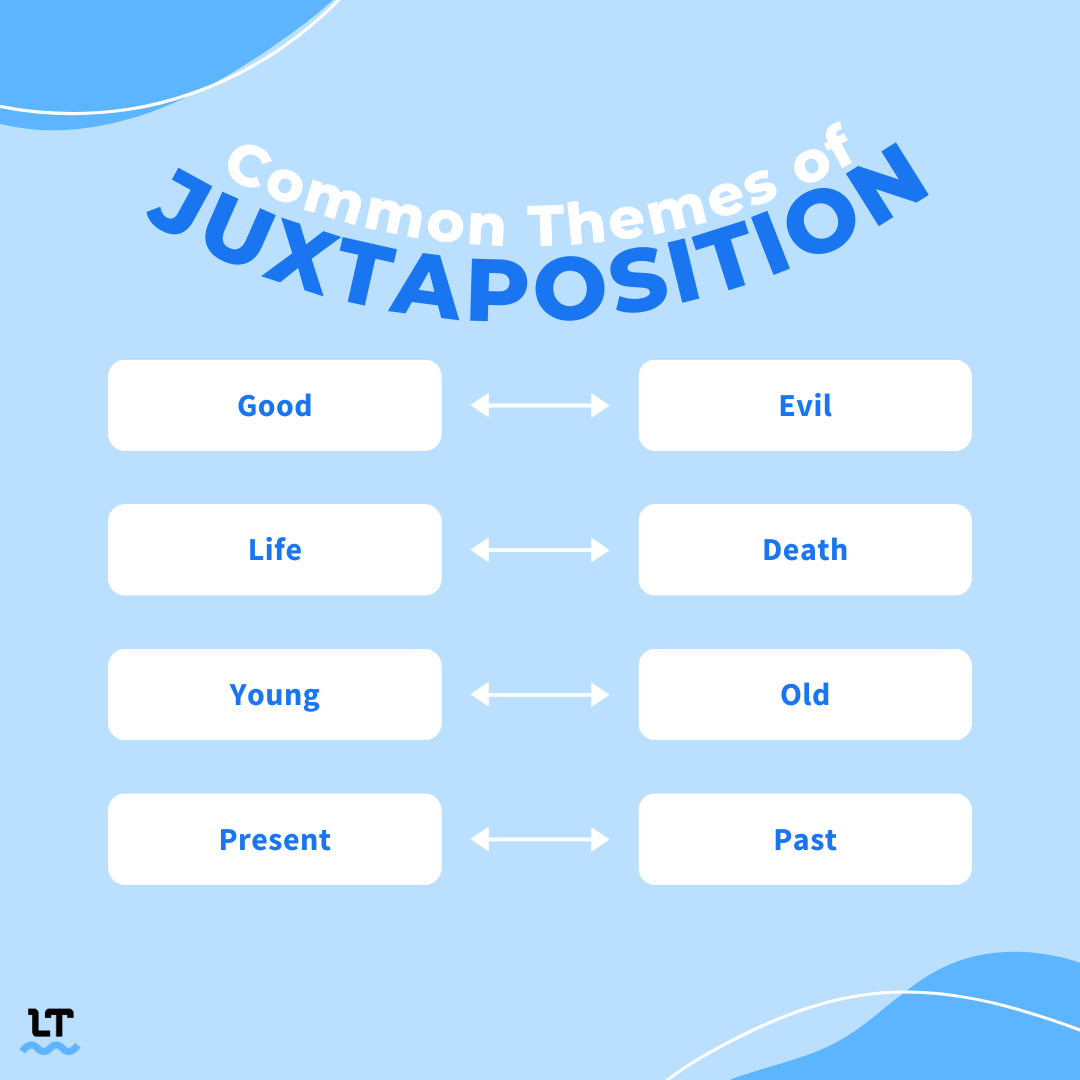What Is “Juxtaposition”? Quick Summary
Juxtaposition is when two opposite elements (like ideas, characters, themes, etc.) are presented next to each other to create a desired effect or highlight their differences.
- She was the light in my dark world.
Juxtaposition: Table of Contents
Juxtaposition is One Tool That Can Elevate Your Writing, but There’s Another
Juxtaposition: Definition
Juxtaposition is a literary and rhetorical device in which two contrasting elements, ideas, images, or characters are presented in close proximity to create a striking effect.
Picture a family with a relentlessly crying baby on an otherwise peaceful and quiet beach. Now imagine an extraordinarily black bear rolling around in blinding white snow. What do those two scenes have in common?
Both contain juxtaposition.
You may be wondering why writers would want to use juxtapositions in their writing. One would be to highlight differences and therefore evoke emotions, emphasize something, or grasp the audience’s attention. However, juxtaposition may also serve to connect seemingly unrelated themes. It can also help highlight the intricacies of a characteristic or concept that a reader might otherwise overlook.
In short, juxtaposition is a way to encourage readers to compare, contrast, and evaluate particular elements that are relevant to the text.

Examples of Juxtaposition
There are numerous juxtaposition themes that writers frequently use in their writing. We’ll explore a few of them below and provide examples of how they may be presented.
1. Good and Evil
Juxtaposing good and evil allows readers to explore the complexities of morality, righteousness, and wickedness.
A man is at a fork in the road; one gives him everything he thinks he wants but leads him to wickedness, and the other offers love and leads him to happiness.
2. Love and Hate
These intense feelings can be contrasted to show the intensity and transformative nature of relationships.
A young woman has a loving and kind relationship with her mother but a disastrous and hateful relationship with her father.
3. Life and Death
Writing about life and death can make readers notice the fleeting nature of life and the profound impact of mortality.
A vibrant field of bright flowers blooms in a cemetery.
4. Young and Old
Juxtaposing youth and old age can help showcase the themes of energy and innocence on the one hand and wisdom and experience on the other.
A great-great-grandmother holds her great-great-granddaughter.
5. Nature and Human Civilization
Writing about nature and human civilization helps contrast the seamless beauty and harmony of the natural world with the sometimes chaotic constructs of human society.
A flower grows through the crack of a sidewalk.
6. Innocence and Corruption
The juxtaposition of innocence and corruption can help demonstrate the contrasts between the purity and naivety that stem from innocence and the influence of corruption in the form of greed or power.
A young child is playing joyfully with dollar bills as an older man assertively takes them away and stuffs them into a piggy bank.
7. Wealth and Poverty
Writing about wealth and poverty can highlight the disparities between affluence and destitution.
Someone drives a Rolls-Royce with gold-plated rims through a poor neighborhood that seems abandoned, but it’s not.
8. War and Peace
Contrasting war and peace allows for the exploration of the grave difference between conflict and tranquility, and destruction and serenity.
A white dove flies over a battlefield.
9. Past and Present
Juxtaposing past and present can help readers see the influence of history and tradition and compare it to the demands, modernity, and progress of the present.
A digital clock sits on top of an antique grandfather clock.
10. Freedom and Confinement
Writing about freedom and confinement can juxtapose the yearning for liberation, individualism, and self-expression with the constraints of societal norms, expectations, and even systems like prisons that literally keep one confined.
A bird in a cage that’s hanging from a tree is surrounded by other free birds.
Juxtaposition in Literature
Examples of juxtaposition abound in literature. If you’re looking for some, here are a few quotes, lines, or passages from famous authors.
It was the best of times, it was the worst of times, it was the age of wisdom, it was the age of foolishness, it was the epoch of belief, it was the epoch of incredulity, it was the season of Light, it was the season of Darkness, it was the spring of hope, it was the winter of despair, we had everything before us, we had nothing before us, we were all going direct to Heaven, we were all going direct the other way—in short the period was so far like the present period, that some of its noisiest authorities insisted on its being received, for good or for evil, in the superlative degree of comparison only.
—Charles Dickens (A Tale of Two Cities)
War is peace. Freedom is slavery. Ignorance is strength,
—George Orwell (1984)
We adore chaos because we love to produce order.
—M.C. Escher
Parting is such sweet sorrow.
—William Shakespeare (Romeo and Juliet)
In the midst of winter, I found there was, within me, an invincible summer.
—Albert Camus
Juxtaposition is One Tool That Can Elevate Your Writing, but There’s Another
Just like idioms and rhetorical questions, juxtaposition is an incredibly effective device that can help enhance your writing and create desired effects. That’s why it’s been used so often in the past and will continue to be used in the present and future.
There’s another way to easily elevate your writing from just okay to exceptional, and that’s by using LanguageTool. This advanced multilingual writing assistant not only corrects various types of errors, but it can also provide stylistic suggestions to improve the flow, tone, and clarity of your text.
Try it to start transforming your writing today!

